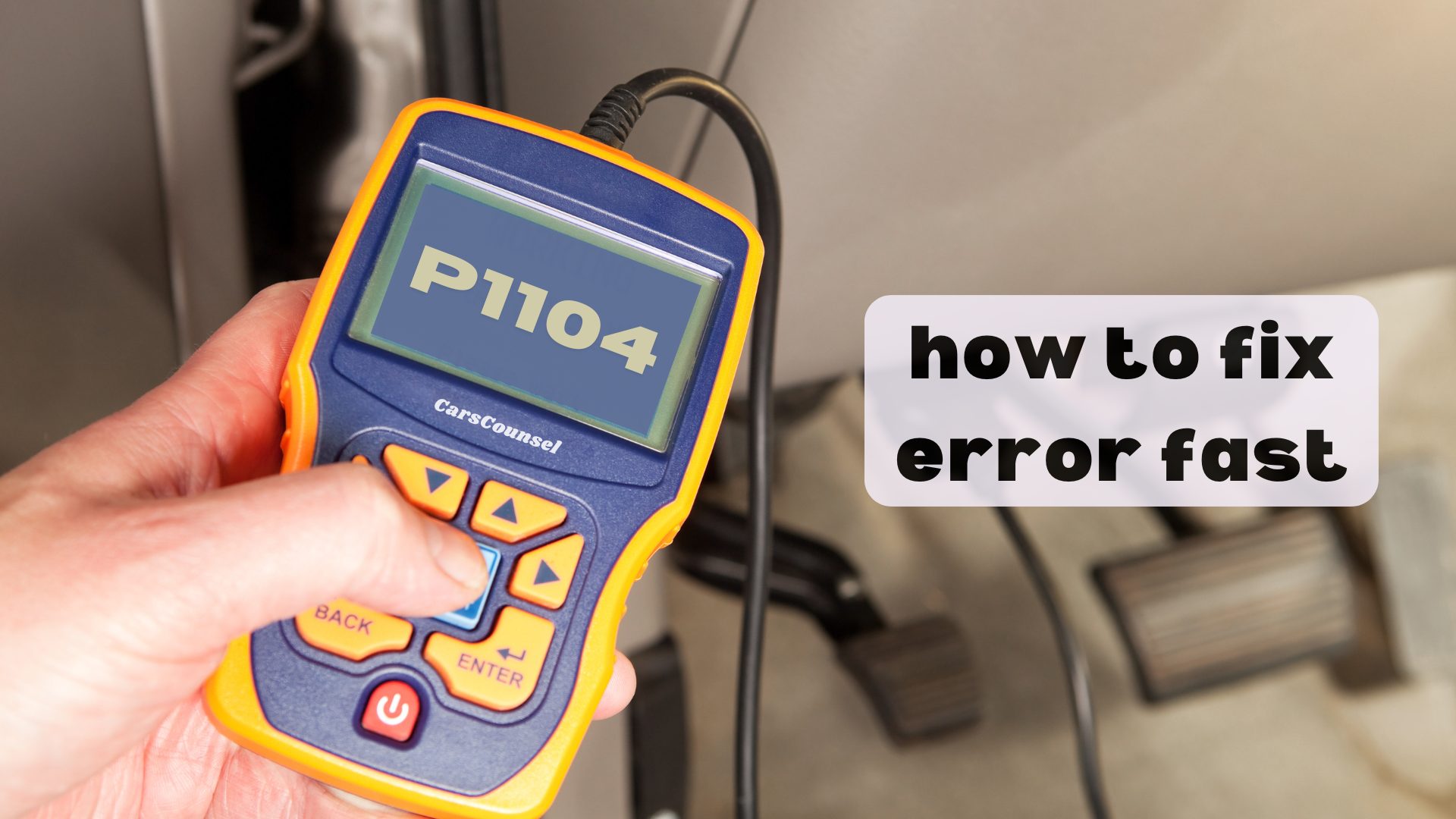If you’re seeing a P1104 code on your dashboard, it’s likely your vehicle’s Manifold Absolute Pressure (MAP) sensor is malfunctioning, causing low voltage issues. This sensor is vital for your engine’s performance, as it measures intake manifold pressure to determine the ideal air-fuel mixture.
But what’s behind this error code? Is it a faulty sensor, wiring issues, or perhaps a vacuum leak?
The symptoms – decreased fuel efficiency, engine hesitation, and rough idling – are frustrating, but understanding the root cause is key to resolving the issue. Now, let’s take a closer look at what might be driving this problem.

Quick Navigation
Key Takeaways
- A P1104 code indicates a low voltage issue with the Manifold Absolute Pressure (MAP) sensor, affecting engine performance and fuel efficiency.
- A faulty MAP sensor or wiring issues can cause a low voltage signal, triggering a P1104 code and impacting engine control module (ECM) or powertrain control module (PCM) function.
- Vacuum leaks in the intake system or ECM/PCM malfunctions can also trigger a P1104 code, requiring a thorough inspection to identify the root cause.
- Symptoms of a P1104 code issue include decreased fuel efficiency, engine hesitation, rough idling, stalling, misfires, and loss of power.
- Replacing a faulty MAP sensor requires precision and attention to detail, including inspecting and cleaning the sensor and its connections to ensure proper installation.
Understanding Code P1104
When your vehicle’s onboard diagnostics (OBD) system flags a P1104 code, it’s indicative of a specific issue with the Manifold Absolute Pressure (MAP) sensor.
This sensor’s primary function is to measure intake manifold pressure, which helps the engine control module (ECM) or powertrain control module (PCM) determine the correct air-fuel mixture for combustion.
The MAP sensor has a rich history, dating back to the 1980s, when it was first introduced as a means to optimize engine performance.
Today, it remains a pivotal component in modern engine management systems.
A faulty MAP sensor can lead to incorrect fuel delivery, timing, and overall engine performance, which is why understanding code P1104 is essential for proper diagnosis and repair.
Common Causes of the Issue
What triggers a P1104 code?
Typically, it’s a faulty Manifold Absolute Pressure (MAP) sensor, which measures intake manifold pressure to help your engine control module (ECM) or powertrain control module (PCM) determine the correct air-fuel mixture.
When the MAP sensor fails, it can’t provide the necessary voltage, leading to incorrect fuel delivery, timing, and overall engine performance.
Wiring issues can also cause a P1104 code.
Damaged wiring or connectors in the sensor circuit can prevent the MAP sensor from sending the correct voltage signal to the ECM/PCM.
Additionally, vacuum leaks in the intake system, ECM/PCM malfunctions, and intake manifold issues can also trigger a P1104 code.
Identifying the root cause is vital to resolving the issue and getting your engine running smoothly again.
Recognizing the Symptoms
Several telltale signs indicate that your vehicle’s engine is experiencing a P1104 code issue.
If you notice decreased fuel efficiency, it could be a sign that your engine is struggling to run efficiently.
Engine hesitation or jerking during acceleration is another common symptom, which can be unsettling and affect your driving experience.
Rough idling or stalling, engine misfires, and loss of power are also indicative of a P1104 code issue.
These symptoms can be frustrating and impact your vehicle’s performance.
It’s essential to address these issues promptly to avoid further damage and costly repairs.
Diagnosing the Problem
Your vehicle’s P1104 code diagnosis begins with a thorough inspection of the MAP sensor, its wiring, and connectors.
Check for signs of physical damage, corrosion, or wear on the sensor and its connections. Next, use a multimeter to test the MAP sensor’s voltage output, verifying it’s within the manufacturer’s specified range.
Voltage fluctuation can indicate a faulty sensor or wiring issue. You may also need to perform a sensor calibration to guarantee accurate readings.
Additionally, inspect the intake manifold for vacuum leaks, which can affect the MAP sensor’s performance. By methodically ruling out these potential causes, you’ll be closer to identifying the root problem behind your P1104 code.
Repairing the MAP Sensor
Replacing a faulty MAP sensor requires precision and attention to detail to guarantee proper engine performance. Before replacing the sensor, it’s essential to inspect and clean the sensor and its surrounding area to verify no debris or dirt is interfering with the signal. You can use a soft-bristled brush or a can of compressed air to gently remove any dirt or debris.
| Sensor Cleaning Method | Effectiveness |
|---|---|
| Soft-bristled brush | Effective for removing loose dirt and debris |
| Compressed air | Effective for removing dust and dirt from crevices |
| Chemical cleaning solutions | Not recommended, as they can damage the sensor |
| High-pressure water spray | Not recommended, as it can damage the sensor or its electrical connections |
Additionally, check for voltage fluctuations in the sensor circuit, as this can also affect the sensor’s performance. By following these steps, you can confirm a proper repair and prevent future issues with your MAP sensor.
Replacing the Faulty Sensor
With the MAP sensor cleaned and inspected, you’re now ready to replace the faulty sensor with a new one.
This is a vital step in resolving the P1104 code, as a faulty sensor can cause voltage fluctuations that lead to incorrect fuel delivery and timing.
When replacing the sensor, verify you follow the manufacturer’s guidelines to avoid any installation errors.
- Purchase a new MAP sensor that meets the manufacturer’s specifications
- Disconnect the electrical connector from the old sensor
- Remove the old sensor from the intake manifold
- Install the new sensor, certifying it’s securely fastened and the electrical connector is securely attached
Additional Costs and Considerations
Now that you’ve replaced the faulty MAP sensor, it’s time to weigh the additional costs and considerations that come with resolving the P1104 code. These costs can add up quickly, so it’s essential to factor them into your repair estimate.
| Cost Component | Estimated Cost |
|---|---|
| Labor rates | $75-$150 per hour |
| Diagnostic fees | $50-$100 |
| Replacement parts | $50-$200 |
| Maintenance schedules | $20-$50 |
| Additional repairs | $100-$500 |
Keep in mind that these costs can vary depending on your vehicle’s make and model, as well as the labor rates at your local auto repair shop. Be sure to consult with a professional mechanic to get an accurate estimate based on your vehicle’s specific needs.
Vehicle-Specific Information
Precision is key in terms of diagnosing and repairing vehicle-specific issues related to the P1104 code.
You’ll need to consult your vehicle’s repair manual or online resources to get accurate information on the MAP sensor’s location, wiring diagrams, and troubleshooting procedures specific to your make and model.
- Audi Variations: Check for specific guidelines on testing and replacing the MAP sensor on Audi models, as they may differ from other manufacturers.
- Hyundai Differences: Be aware of Hyundai’s unique MAP sensor calibration procedures and potential software updates that may be required.
- BMW Model-Specific Wiring: Familiarize yourself with the wiring diagrams and connector locations on BMW models, which can vary significantly from other manufacturers.
- Manufacturer-Specific Diagnostic Tools: Use diagnostic tools and software recommended by your vehicle’s manufacturer to guarantee accurate readings and proper repair procedures, and to verify that all steps are followed correctly.
More OBD-II Codes
Conclusion
As you navigate the twists and turns of code P1104, bear in mind that a faulty MAP sensor can be a ticking time bomb, waiting to trigger a storm of engine troubles. Don’t let it hijack your vehicle’s performance – diagnose and repair it promptly. With the right tools and knowledge, you can tame the beast and get back on the road, where the only storm you’ll face is the one outside your windshield.

